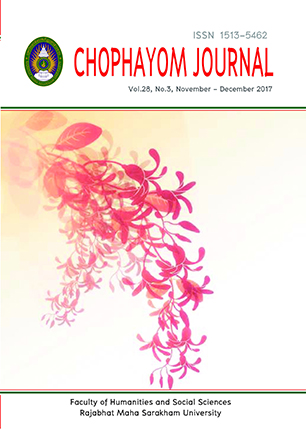Factors Affecting Sustainable Application of the Sufficiency Economy Philosophy of Households in Maha Sarakham Province
Keywords:
Sufficiency Economy Philosophy, Sustainable, Self-relianceAbstract
Abstract
The objectives of this research were 1) to study the general background information of household heads who participated in the sufficiency economy project in Maha Sarakham province, 2) to compare the characteristics of the two groups of household heads: the ‘sustainable’ group and the ‘unsustainable’ one, 3) to study the factors affecting household heads’ sustainable application of the sufficiency economy
philosophy after the end of the development project in Maha Sarakham province. The sample population consisted of 400 subjects obtained by using Multi-stage Sampling, and the instrument used in data collection for this study was an interview form, typical of a questionnaire, with 0.86 - 0.94 reliability for each factor. The statistics used in data analyses were Frequency, Percentage, Mean, Standard Deviation and t-test (Independent Samples), Stepwise Discriminant Analysis, and Canonical Correlation Analysis. Findings of the study revealed that the majority of household heads are male (87.00%); their mean age is 49 years ( = 49.38 S.D. = 6.09) with 41 - 50 years being the majority age group (38.50%); most of the respondents are married( 94.50%); the educational level of the majority is elementary education(49.50%); their main practices based on the sufficiency economy reduced household expenses, e.g. planting home-grown vegetables such as hot peppers, eggplants, string beans, papayas, garlic, onion, galangal, coriander, mint, etc; animal husbandry & aquaculture such as raising frogs, catfish, black chickens, chickens of three hybrid species, crickets, etc; while sustainable sufficiency economy activities are those that raised family income such as
raising frogs, catfish, black chickens, chickens of three hybrids, crickets, meat cows, milk cows, pigs, etc; including weaving local fabric materials and mushroom culture. Regarding characteristics of the household heads of the ‘sustainable’ and ‘unsustainable’ groups,
the study revealed that there are significant differences in the following 10 factors or aspects at the .05 level of statistical significance: number of visits by study groups or individuals, technical skills, job position or community role, importance of sufficient water resources, attitude toward the sufficiency economy philosophy, inspiration for success, knowledge sharing, enthusiasm in occupation, self-confidence, and level of learning achievement, The factors affecting sustainable application or practice based on the sufficiency economy of household leaders in Maha Sarakham province at the .05 level of statistical significance are knowledge sharing, enthusiasm in occupation , attitude toward the sufficiency economy philosophy , number of visits by study group or individuals, level of learning achievement and importance of sufficient water resources. The six factors favorably affecting sustainable application of the sufficiency economy philosophy can be entered into a
distribution equation with raw scores to predict probability of group membership as follows: Y = - 24.11 + 0.56 (knowledge sharing) + 1.16 (enthusiasm in occupation) + 0.99 (attitude toward the sufficiency economy philosophy) + 0.35 (number of visits by study groups or individuals) + 0.10 (level of learning achievement) + 0.72 (importance of sufficient water resources) When this distribution equation is tested with the sample of 400 subjects to predict probability of the sustainable and unsustainable group membership, the prediction is 99.00% in accuracy.
Keyword : Sufficiency Economy Philosophy , Sustainable , Self-reliance






